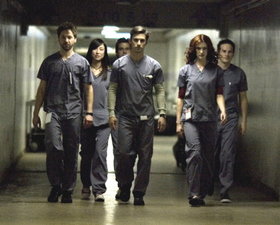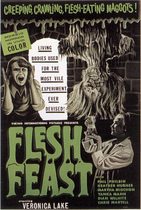Our editor-in-chief Nate Yapp is proud to have contributed to the new book Hidden Horror: A Celebration of 101 Underrated and Overlooked Fright Flicks, edited by Aaron Christensen. Another contributors include Anthony Timpone, B.J. Colangelo, Dave Alexander, Classic-Horror.com's own Robert C. Ring and John W. Bowen. Pick up a copy today from Amazon.com!
"Pathology" Set Visit
The camera slides on a track, following actor Michael Weston as he pontificates to his fellow pathologists. A murder victim lies on a slab in the center of the room. Like so many detectives before them, these characters are trying to figure out the cause of death. Unlike most murder mysteries, though, they're not trying to bring the killer to justice. In fact, the killer is sitting in the room, drinking a beer and watching the proceedings with a smug look. For these pathology students, killing is a game - a way to show off their smarts. Who among them can commit the perfect murder; a death so subtle that their fellow killers can't even detect the cause?
Classic-Horror recently visited the set of Pathology, a new horror-thriller scheduled to be released by MGM in November of this year. Milo Ventimiglia stars as Ted Gray, a pathology student who gets swept up in a psychotic game.
"He's a guy who's typically in control and finds himself in a very uncontrolled situation with a group of people who are unstable and like to kill," Milo says of his character. "He gets seduced and enticed by the world of it, and the curiosity and intrigue of knowing everything about the human body, how it functions, how it can stop functioning and be undetected."
Michael Weston plays Jake, the leader of this group. "They're very smart, outcast characters," he says. "All that time spent around dead bodies, living in basements, doing drugs - it's twisted them. They're all psychotic." Jake, who becomes Ted's adversary, is the most psychotic of all. Chip (Dan Callahan) is "a little more sensitive." Michael says, "As the group goes over the edge, Chip holds them back." At least for a little while.
How does Ted, the "hero" of the story, get entangled in this group? "It's like a drug. He falls into that world. He has to be in it and get out of it cleverly and try and be undetected," Milo says. "I think it comes down to a seduction of a world he doesn't know. It's a loss of control for being a guy who's in control of things. To have that control within an unstable situation - to be in a world where he could be caught for murder - I think that's gotta be freeing, to a point."
Screenwriter Mark Neveldine says, "Something interesting, and scary, about doctors is that they do look at us objectively and they are detached. What we're doing with this movie is taking that detachment and pushing it as far as we can to the point where - they're not playing God, so much? But they're not afraid to kill people, and play a game with people."
Mark likes to hang out at the L.A. County Morgue in his spare time. "I'm kind of like Norm down there." He and his writing partner, Brian Taylor, came up with the idea for Pathology in a bar one night.
"'Let's make something different than just a horror film about autopsies. Let's really make a game between brilliant doctors, and have this competition come out,'" Mark remembers. "That was the initial part of how that came about."
Real forensic pathologists see autopsies as puzzles to solve, much like the characters in the movie. "I brought all the actors down there for research before the movie began," Mark says. "Anytime a body would come in -- there were ten, twelve bodies that came in every day and there are like 300 bodies at any given period in the morgue -- with every body, you're trying to figure out how this person died? You'd watch the autopsy and everybody'd sort of take their little guesses and then we'd find out that a guy was stabbed with a Stanley screwdriver - that was one of the cases - or poisoned. Or drug overdose. Or car accident. And these are accidental or unnatural deaths. If someone died at their house of old age, they're not going to bring them in for an autopsy, unless there's something suspicious. So, it's a lot of fun, in a sick sort of way."
As Mark and I talk, an artificial cadaver is rolled out onto the soundstage. The body is cut open and the ribs splayed out for an autopsy. I can look into the chest cavity, but the organs are missing. An extra head sits on the table next to the body, its skin tinted green and its eyes blank.
"We're going to chop off this guy's head," Mark says.
The cadaver is made with exquisite detail by Patrick Tatopoulos Designs, Inc. Viewed up close, it's creepily realistic - I can even see the pores on the skin.
"This is who we call Mr. Ribs," Mark says. "These are N.D. bodies - non-descript bodies. And others we have actors who are killed - we put appliances on them. Or we have done some full body replicas of the actors. I can't give all those details away - no spoilers."
Cast and crew who have a bit of idle time wander over to look at the body. They try to figure out who the corpse is supposed to be. One of the actors sitting nearby realizes, "Oh, that's the one I kill!"
Mark and Brian like to write by getting into the minds of their characters. "There's a lot of Brian in myself and Ted and Jake and even the girls. It's fun. It's fun to dive into that psychology about these detached, cold people, and what it's like to take another human's life, and how to come up with a creative way to take a human life."
This is the second film Mark Neveldine and Brian Taylor have written together (the first was the high-adrenaline action/comedy Crank). They met as camera operators on a film shoot in Tahoe and bonded right away. "We realized we were both drunks and had a good time, and liked filming and liked being dangerous with filming. I mean, we shoot out of helicopters, on roller blades, off the backs of motorcycles. I didn't know there was another guy that was like me."
Mark and Brian are both producers on the film as well, and they're on the set nearly every day. While Mark and I are speaking, one of the actors approaches.
"Johnny Witworth. What's happening?" Mark greets him.
" I had a sneaking suspicion - did you tell Mike to do anything weird to me when I do my thing?" Johnny asks.
"Probably not. Or probably. Depends," Mark teases. "Don't be paranoid, though. A scalpel to the gut doesn't hurt."
"Okay, if you said no, I wouldn't be paranoid. But now I'm thoroughly paranoid. Thanks a lot! " Johnny says, and returns to the set.
The cast and crew have a friendly relationship with each other, goofing around and teasing each other between takes.
Milo says he liked the script when he first read it, but it was really the producers and director who won him over to the project. "I thought, okay, it was a cool script and could go in a million directions depending on the people involved, but I liked the character," he says. "It wasn't until I spoke to Schoelermann, the director, and Neveldine and Taylor, the writers, who told me exactly what they're looking to do, what they wanted to do, and I said, 'I think I can do that.' That's when I signed on."
A lot of the draw for Milo, best known as good-guy Peter Petrelli on "Heroes", was playing an anti-hero. "For me as an actor, it was a bit of a challenge to make the hero of the story somewhat likeable when he's doing all these bad things," Milo says. "I thought it would be fun to play with the idea that's within all of us - the idea of killing. The physics of killing is very basic. The amount of pressure it takes to pull a trigger or stab someone - it's simple. It's the rationale of whether we do it or not do it."
"Pathology kind of is a thriller, it's part horror, it's part very dark drama," Mark says. "But the great thing about it is this is not a classical horror film. It's really a smart thriller with a lot of horror in it that people are going to love. At the end of the day, it's a group of doctors who are playing a really f**ked-up game."
"I think the first and last scene of this movie will probably scar people for life."








